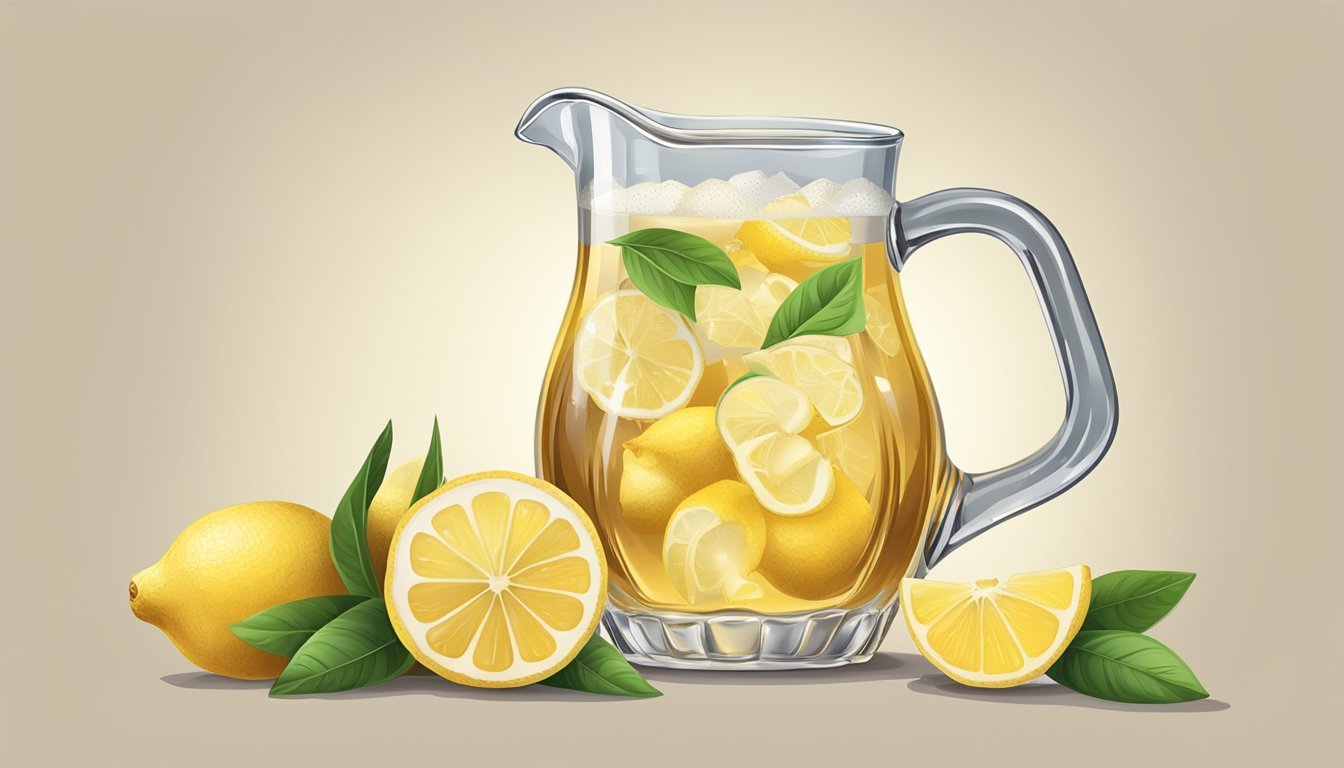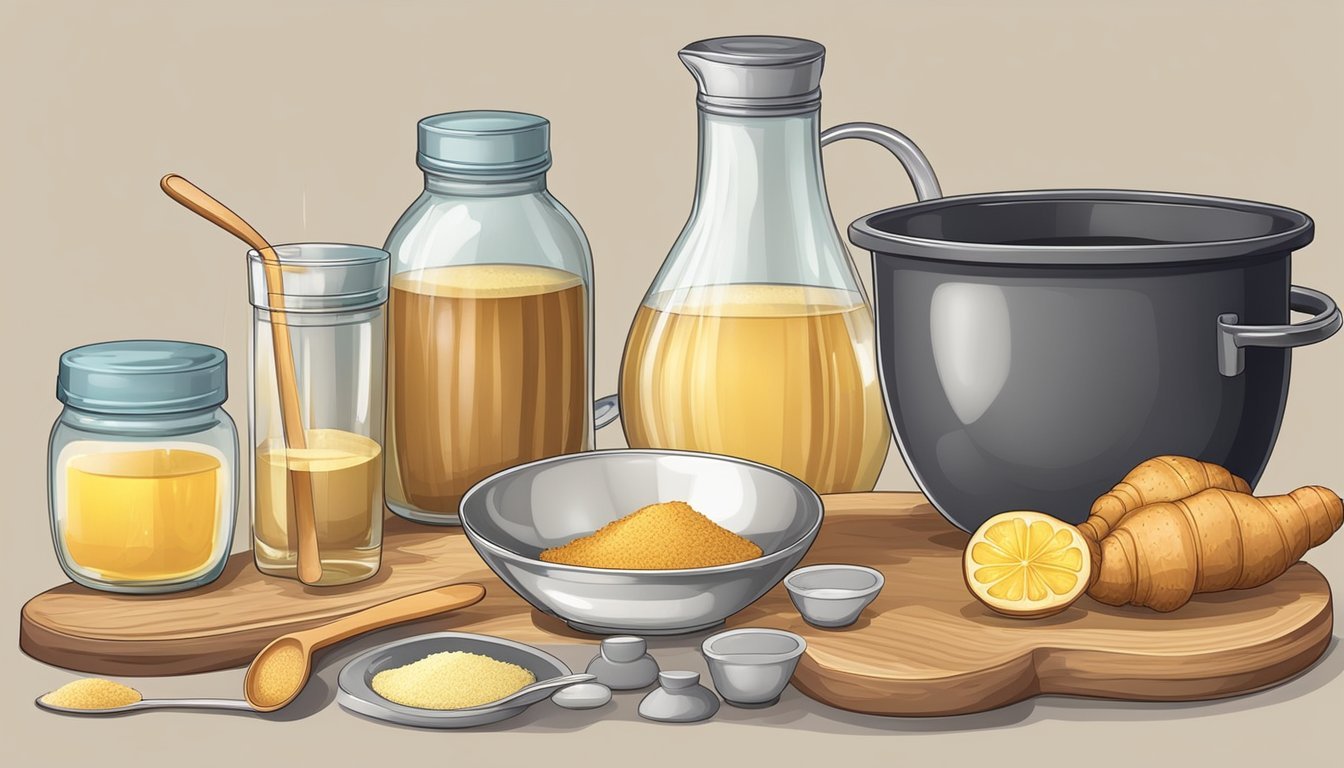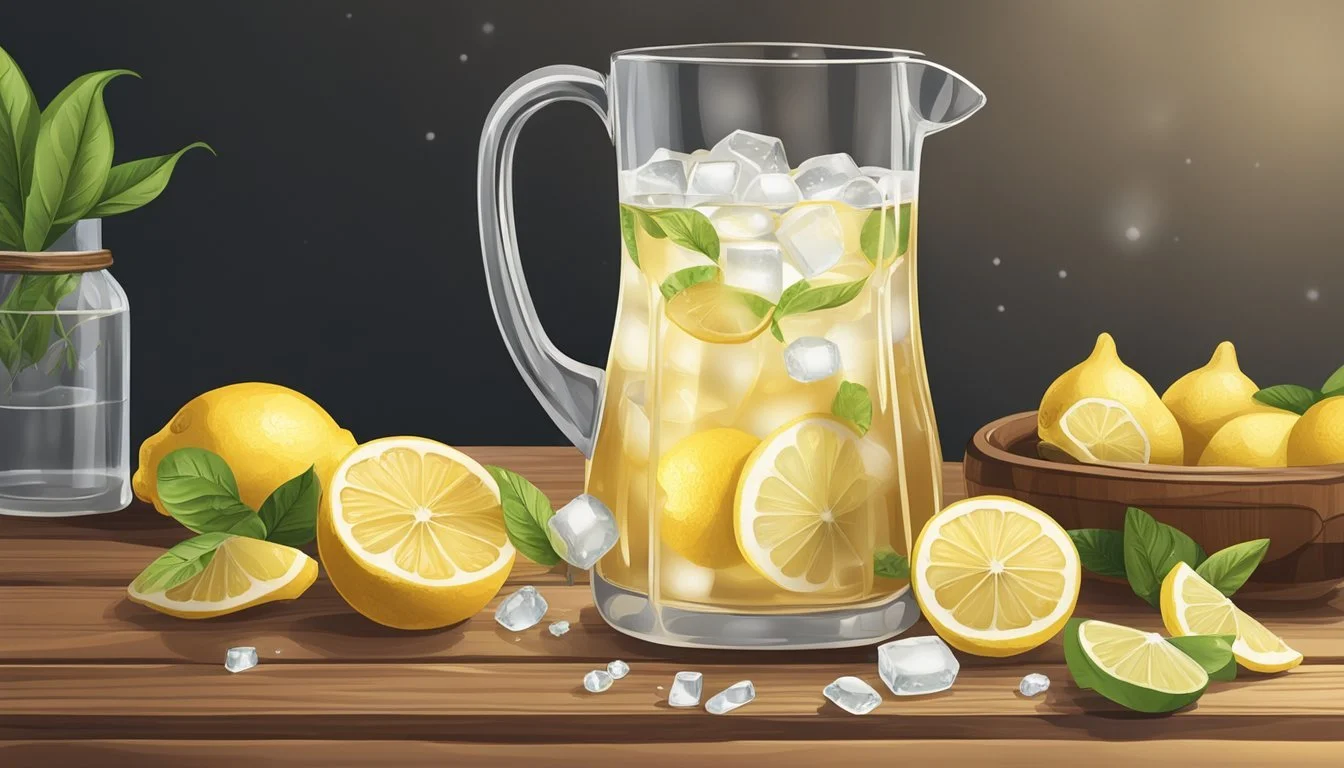Ginger Beer Recipe
Ginger beer, a spicy and invigorating soft drink, has a rich history and a diverse range of brewing methods. Unlike its milder cousin ginger ale, ginger beer is crafted through a fermentation process that imbues it with a stronger ginger flavor. It begins with fresh ginger root, which is the key ingredient. Grated or finely chopped, the fresh ginger infuses the beverage with its characteristic pungent and warming qualities. A ginger bug, which is a starter culture made from fresh ginger, sugar (how long does sugar last?), and water, often jumpstarts the fermentation.
Traditional ginger beer recipes call for a combination of fresh ginger, sugar—typically raw or cane sugar—and clean cold water. The sugar serves as food for the natural or added yeast, which initiates the fermentation necessary to produce the subtle alcoholic content and carbonation. Lemon or lime juice is sometimes added to complement the ginger's heat with a citrusy zing. While most homebrews have a relatively low alcohol content, the focus is on flavor rather than intoxication, making ginger beer a popular choice both for personal consumption and as a mixer in cocktails, such as the Moscow Mule.
To customize the brew, the maker may adjust the amount of sugar, the fermentation time, and the strain of yeast. Some opt for brown sugar to impart a deeper flavor profile. During the fermentation process, the ginger beer must be stored properly, typically in clean plastic bottles or other air-tight containers, away from direct sunlight. Once bottled, the pressure must be monitored to avoid over-carbonation. The final product is a refreshing and sometimes spicy beverage that showcases all the complexities of its organic ginger content.
Historical Background
In tracing the roots of ginger beer, one uncovers a rich tapestry of traditional brewing methods and its cultural imprint across various societies. The infusion of zesty ginger with varying sweeteners marks a history of evolution from a homemade folk remedy to a globally enjoyed soft drink.
Authentic Ginger Beer Origins
The genesis of ginger beer can be traced to the 18th century in Yorkshire, England, where it began as a fermented alcoholic beverage made from fresh ginger, sugar, generally water, and sometimes included ingredients such as lemon juice or cream of tartar (how long does cream of tartar last?). The fermentation process was integral for developing its distinct ginger flavor and characteristic fizz.
In a typical recipe, grated ginger is combined with sugar—often brown sugar or molasses (how long does molasses last?) for richer flavor—and water, creating what is known as the ginger mixture. This concoction was left to ferment, with wild yeasts from the air or a ginger bug starter—a culture of beneficial bacteria and yeasts. After fermenting, the mixture had a notable alcohol content and a pungent ginger punch.
Cultural Significance
Ginger beer transcended its origins as a domestic brew to become a key component in many cultural events and social traditions. It evolved into a non-alcoholic soft drink akin to ginger ale but retained its robust taste. Its presence in favorite cocktails like the Moscow Mule, which combines ginger beer with vodka and fresh lime juice, underscores its lasting influence in the culinary world.
As a versatile ingredient or stand-alone beverage, it reflects personal tastes with variations such as adding maple syrup (how long does maple syrup last?) or honey instead of white sugar, or intensifying the ginger essence by using organic ginger or aged ginger root. The choice between creating a spicy beverage with a dry yeast kick or a milder, sweetened drink lies in the personal preference of the brewer, showcasing ginger beer's adaptability and timeless appeal.
Ingredients and Supplies
Creating homemade ginger beer requires attention to detail with both the ingredients and equipment used in the process. Choosing high-quality ingredients and having the right equipment on hand are crucial steps that affect the flavor and success of the final product.
Choosing Quality Ingredients
The quality of ginger beer is largely dependent on the freshness of the ginger used; organic ginger is preferable for its robust flavor. A combination of granulated or brown sugar is used to feed the wild yeasts during the fermentation process. For additional sweetness and flavor complexity, options like maple syrup or raw sugar (how long does raw sugar last?) can be considered. Commonly, fresh lime juice or lemon juice is added to provide a citrusy note. The specific quantity of these ingredients will vary depending on the recipe, but generally, an appropriate ratio maintains the balance between the spicy and sweet tastes characteristic of traditional ginger beer.
Here's a list of ingredients for a ginger-based recipe, with specified quantities and their respective purposes:
Fresh Ginger Root:
Quantity: ¼ cup, grated
Purpose: Base ginger flavor
Sugar (Brown or White):
Quantity: 5 tbsp
Purpose: Fermentation & sweetness
Lemon Juice or Lime Juice:
Quantity: 1 tbsp
Purpose: Acidity & freshness
Water:
Quantity: 3 ½ cups
Purpose: Dilution & volume
Ginger Bug Starter:
Quantity: ¼ cup
Purpose: Fermentation
Essential Equipment
The right equipment will ensure safe fermentation and storage. For the initial mixing and steeping of the ginger mixture, a clean saucepan and a fine mesh strainer are needed to ensure that only the liquid without bits of ginger or pulp moves to the fermentation stage. Fermentation requires a glass jar, a breathable cloth or coffee filter, and a rubber band to cover the opening, which prevents contamination while allowing gases to escape. For bottling, air-tight plastic bottles or glass bottles with secure caps are recommended, as they can handle pressure from carbonation without risk of explosion. It's also important to store the ginger beer out of direct sunlight to maintain optimal fermentation conditions.
Here's a list of equipment needed for making ginger beer, along with their functions:
Fine Mesh Strainer:
Function: To strain the ginger pieces from the mixture
Glass Jar (1-liter):
Function: For mixing ingredients and fermenting
Breathable Cloth:
Function: To cover jar during fermentation
Rubber Band:
Function: To secure the cloth
Plastic or Glass Bottles:
Function: For storing the finished ginger beer
Careful measurement and handling of both the ingredients and equipment will contribute to producing a delicious homemade ginger beer that can be savored on its own or incorporated into a favorite cocktail, like Moscow mules.
Preparing the Ginger Beer
Creating homemade ginger beer combines the zest of fresh ginger with the excitement of carbonation. Grating the ginger exposes its pungent flavor, while fermentation brings about the beverage's effervescence.
Mixing the Recipe
Begin with fresh ginger root, selecting a piece with firm skin and a spicy aroma to ensure a robust ginger flavor in the final product. Peel and grate the ginger, then mix it with cups of water—usually around two to three cups—for potency. Sweeteners like granulated sugar or brown sugar are dissolved in the water mixture, often heated to form a simple syrup. Add fresh lime or lemon juice to the mixture to provide a refreshing citrus note.
Fermentation Process
For fermentation, introduce a ginger bug starter or a small quantity of dry yeast to kick off the process. This ginger mixture should be transferred to a container suitable for fermentation, covered with a cloth or a loose lid to allow gases to escape. The temperature is critical: the mixture should be kept in a warm place but out of direct sunlight for fermentation to proceed, which typically takes between three days and one week. During this time, wild yeasts or the added yeast consume the sugars, resulting in natural carbonation.
Bottling and Carbonation
Once the fermentation process is complete, you're ready to bottle the ginger beer. First, strain the brew to remove bits of ginger pulp, transferring the clear liquid into clean plastic bottles or glass bottles with secure closures. Leave some headspace to accommodate carbonation. If a sweeter drink is desired, additional sugar or natural sweeteners like maple syrup or honey can be added at this stage. Seal the bottles tightly and store them to carbonate for a further 12 to 48 hours. Monitor the bottle pressure carefully; the buildup should be released periodically to prevent over-carbonation, risking bottle eruption. Once the desired carbonation level is achieved, refrigerate to halt the fermentation, and enjoy your homemade ginger beer chilled.
Serving and Variations
When serving homemade ginger beer, there are traditional ways to enjoy its vibrant ginger flavor, and it can also be innovatively paired in various cocktails. Each serving method brings out different nuances of the homemade brew.
Classic Ginger Beer Serving Suggestions
To preserve the effervescence and pungent ginger flavor of homemade ginger beer, it's typically served chilled. Use plastic bottles for storage to monitor the build-up of carbonation and reduce the risk of over-fermentation. Using a ginger bug starter—a fermented mixture of fresh ginger, sugar, and water—can result in a spicy beverage with a generally low alcohol content, suitable for a soft drink. For a sweeter taste, some may opt to add simple syrup or even honey to their prepared servings.
Cocktail Recipes and Pairings
Ginger beer can be used to make various cocktails like the popular Moscow Mule, which combines ginger beer with vodka and fresh lime juice, often garnished with a wedge of lime. The following table showcases two cocktail recipes featuring ginger beer:
Moscow Mule
Ingredients:
2 oz Vodka
6 oz Ginger Beer
1/2 oz Fresh Lime Juice
Ice
Preparation:
Fill a copper mug with ice.
Pour vodka and lime juice over ice.
Top with ginger beer and stir.
Garnish with a lime wedge.
Dark ‘n’ Stormy
Ingredients:
2 oz Dark Rum
3 oz Ginger Beer
1/2 oz Fresh Lime Juice
Preparation:
Fill a glass with ice.
Add dark rum and lime juice.
Top with ginger beer and gently stir.
Garnish with a lime slice.
Alternately, ginger beer can be mixed with fresh lemon juice or a splash of maple syrup to craft a non-alcoholic drink that highlights the organic ginger essence. Regardless of the recipe, ginger beer's bold flavor makes it a versatile ingredient in an array of beverages that cater to both personal preference and a variety of occasions.
Health and Safety Considerations
When creating homemade ginger beer, it is essential to be mindful of the alcohol content and recognize potential fermentation issues. These factors can affect both the quality of the ginger beer and the safety of those consuming it.
Understanding Alcohol Content
Ginger beer, due to its fermenting process involving natural or added yeasts, can develop alcohol content. Fresh ginger root, when combined with a mixture of water and sugar, typically granulated or raw sugar, transforms into a spicy beverage known as ginger beer. The fermentation process can be influenced by the amount of sugar and the type of ginger used, such as organic ginger or aged ginger.
Alcohol Content: Fermented beverages inherently contain some level of alcohol. For those producing ginger beer for personal consumption, it's crucial to understand that the longer the fermentation period, the higher the alcohol content may become.
Legality: The legal threshold for non-alcoholic drinks may vary, but it often falls below 0.5% alcohol by volume (ABV). To ensure homemade ginger beer remains non-alcoholic, a short fermentation time or pasteurization methods can be used to halt the fermentation.
Recognizing Fermentation Issues
Fermentation is a delicate process and can present multiple safety issues if not monitored correctly. Recognizing problematic signs early can prevent potential health risks.
Pressure Build-up: Carbon dioxide is a byproduct of fermentation. When using plastic bottles or air-tight bottles for fermenting ginger beer, it's mandatory to regularly release pressure to avoid bottle explosions. This can be done by slightly unscrewing the bottle cap or using a rubber band and plastic wrap as a makeshift valve.
Contamination: The presence of wild yeasts or unwanted bacteria can spoil the ginger beer, creating off flavors or even making it unsafe to drink. Contamination can occur from improperly cleaned equipment or from the ginger root itself.
Indications of contamination include:
Odd smells, such as sulfur or rotten eggs.
Visible mold, often exhibiting dark clouds or fuzzy growth.
A dramatically altered taste profile, departing from the expected pungent ginger flavor.
Storage: After fermentation, ginger beer should be stored in a cool place away from direct sunlight. While some cloudiness is normal due to bits of ginger pulp, significant changes in color or texture may indicate spoilage.
By paying close attention to the alcohol content and watching for signs of fermentation gone awry, creators can enjoy homebrewed ginger beer that is delicious, safe, and tailor-made to their taste preferences.






